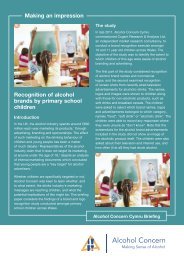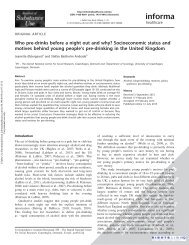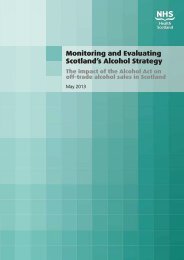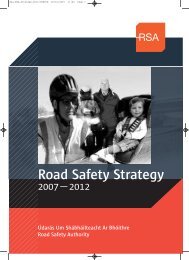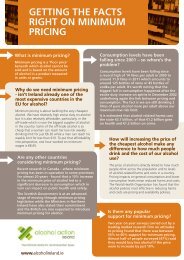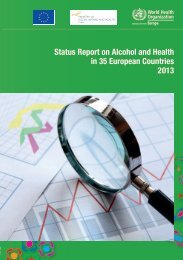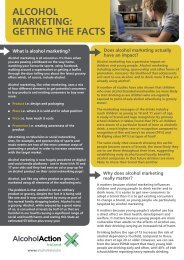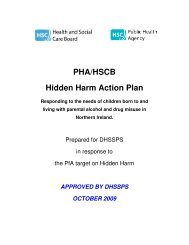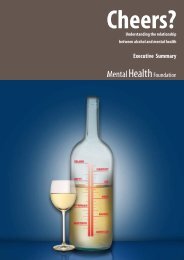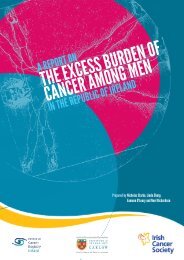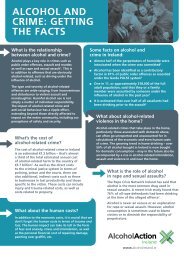Addressing the harmful use of alcohol - WHO Western Pacific Region
Addressing the harmful use of alcohol - WHO Western Pacific Region
Addressing the harmful use of alcohol - WHO Western Pacific Region
Create successful ePaper yourself
Turn your PDF publications into a flip-book with our unique Google optimized e-Paper software.
8. Regulating <strong>alcohol</strong> marketing<br />
Table 8.1 : Legislative examples<br />
Loi Evin, France (1991)<br />
A clear definition <strong>of</strong> <strong>alcohol</strong>ic drinks is given: all drinks over 1.2% <strong>alcohol</strong> by volume are considered<br />
as <strong>alcohol</strong>ic beverages.<br />
Places and media <strong>of</strong> authorized advertising are defined:<br />
- no advertising should be targeted at young people;<br />
- no advertising is allowed on TV and in cinemas; and<br />
- no sponsorship <strong>of</strong> cultural or sport events is permitted.<br />
Advertising is permitted only:<br />
- in <strong>the</strong> press for adults;<br />
- on billboards*;<br />
- on radio channels (under precise conditions); and<br />
- for special events or places, such as wine fairs and wine m<strong>use</strong>ums.<br />
When advertising is permitted, its content is controlled.<br />
Messages and images should refer only to <strong>the</strong> qualities <strong>of</strong> <strong>the</strong> products, such as degree, origin,<br />
composition, means <strong>of</strong> production, patterns <strong>of</strong> consumption.<br />
A health message must be included on each advertisement: “Alcohol ab<strong>use</strong> is dangerous to<br />
health.” (France 2001)<br />
* The text limited billboard advertising to places <strong>of</strong> production and sale. Later, a law change<br />
permitted billboard advertising anywhere that <strong>alcohol</strong> was served or sold.<br />
Options on <strong>the</strong> content <strong>of</strong> <strong>alcohol</strong> advertisements<br />
In a number <strong>of</strong> countries, including Australia and New Zealand, <strong>the</strong> content <strong>of</strong> <strong>alcohol</strong><br />
advertisements is not regulated by government, but comes under systems <strong>of</strong> industry selfregulation<br />
and voluntary codes that set standards for advertising <strong>alcohol</strong> (alongside codes<br />
for o<strong>the</strong>r products, advertising to children, etc.). These <strong>alcohol</strong> advertising codes include<br />
restrictions that originated as government policy, such as no television advertisements before<br />
20:30 or 22:00. Many code rules, such as not linking <strong>alcohol</strong> to sex or social success, health<br />
or violence, and not using actors under 25 years, reflect past complaints by <strong>the</strong> public or public<br />
health organizations. Industry self-regulation <strong>of</strong> <strong>alcohol</strong> advertising now typically includes<br />
pre-vetting and a committee to review complaints that may include non-industry members.<br />
Some codes now include cable, satellite or Internet in <strong>the</strong>ir definition <strong>of</strong> broadcast advertising,<br />
but very few address o<strong>the</strong>r forms <strong>of</strong> marketing.<br />
In <strong>the</strong> European Union, a 1989 Directive on Television without Frontiers included a set <strong>of</strong><br />
minimum rules on <strong>the</strong> content <strong>of</strong> <strong>alcohol</strong> advertising (Article 15), as a basis for national<br />
standards. Some member countries have included this in legislation regulating marketing,<br />
Return to TOC<br />
91



